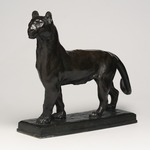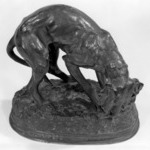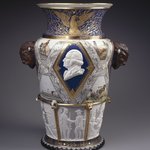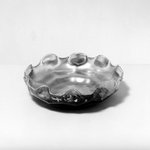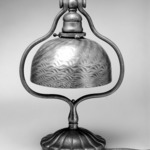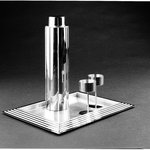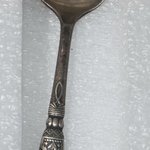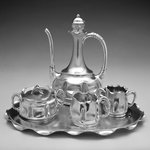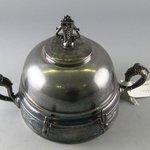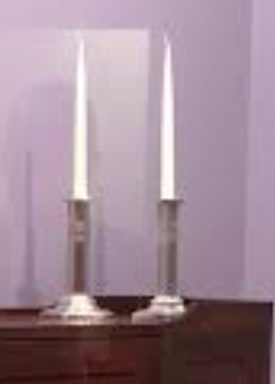
Candlestick, One of Pair
Decorative Arts and Design
On View: Decorative Art, 20th-Century Decorative Arts, 4th Floor
From the 1860s through the 1910s, proponents of the Arts and Crafts movement in both Britain and the United States opposed industrialization and its dehumanizing effects. Instead, they championed honest use of materials, reduction of applied ornament, and interiors with soft, muted colors. One of its earliest British promoters was William Morris, an ardent socialist and designer of the window hanging on view here, who advocated a philosophy of reform that sought to reconnect objects and makers and recast the designer as craftsman.
Through publications and lectures the movement quickly spread to the United States, where it gained popularity as much for its aesthetics as its social ideals. In Massachusetts, the Grueby Faience Company created matte green glazes for its naturalistic art pottery, while the Pairpoint Manufacturing Company produced Arts and Crafts–inspired designs in silver. In upstate New York, Gustav Stickley became a leading proponent of American Arts and Crafts through his influential publication, The Craftsman; his widely distributed, industrially produced furniture equally embodied his mantra of simplicity and honesty of materials and construction. In Southern California, the architecture and design firm of Greene and Greene created fully integrated architecture and interiors filled with luxurious furnishings that accented mahogany chairs with ebony construction details. More idiosyncratic was George Ohr. The self-proclaimed “Mad Potter of Biloxi,” Mississippi, Ohr created eccentric, technically outstanding ceramics using clay dug from the nearby Tchoutacabouffa River.
Through publications and lectures the movement quickly spread to the United States, where it gained popularity as much for its aesthetics as its social ideals. In Massachusetts, the Grueby Faience Company created matte green glazes for its naturalistic art pottery, while the Pairpoint Manufacturing Company produced Arts and Crafts–inspired designs in silver. In upstate New York, Gustav Stickley became a leading proponent of American Arts and Crafts through his influential publication, The Craftsman; his widely distributed, industrially produced furniture equally embodied his mantra of simplicity and honesty of materials and construction. In Southern California, the architecture and design firm of Greene and Greene created fully integrated architecture and interiors filled with luxurious furnishings that accented mahogany chairs with ebony construction details. More idiosyncratic was George Ohr. The self-proclaimed “Mad Potter of Biloxi,” Mississippi, Ohr created eccentric, technically outstanding ceramics using clay dug from the nearby Tchoutacabouffa River.
MEDIUM
Silver-plate
DATES
ca. 1910
DIMENSIONS
7 7/8 x 4 1/2 in. (20 x 11.4 cm) (show scale)



MARKINGS
on bottom: "PAIRPOINT MFG> CO>" Below is a product logo consisting of an irregular-shaped hexagon framing a "P"; and below is stamped "B6119"
SIGNATURE
no signature
INSCRIPTIONS
no inscriptions
COLLECTIONS
Decorative Arts and Design
ACCESSION NUMBER
1989.73.2
CREDIT LINE
H. Randolph Lever Fund
CATALOGUE DESCRIPTION
The candlestick has a hexagonal base, which is flat with shallow sides. Extending from each of six corners are slightly protrusive ribs, which terminate at neck. The center of shaft is incurved, scrolling forward and forming a hexagonal shaped plateau. The stem is hexagonal with straight sides and each side of neck embellished with grid pattern consisting of four vertical rows and three horizontal rows of rectangles. The hexagonal shaped collar has flat, shallow sides and a deep circular-shaped bowl.
CONDITION - Excellent. This candlestick has minor blisters around its base. There are also three scratches on the under side of same base.
EXHIBITIONS
MUSEUM LOCATION
This item is on view in Decorative Art, 20th-Century Decorative Arts, 4th Floor
CAPTION
Pairpoint Manufacturing Company (1880–1929). Candlestick, One of Pair, ca. 1910. Silver-plate, 7 7/8 x 4 1/2 in. (20 x 11.4 cm). Brooklyn Museum, H. Randolph Lever Fund, 1989.73.2. Creative Commons-BY (Photo: , CUR.1989.73.1-.2.jpg)
IMAGE
overall, CUR.1989.73.1-.2.jpg., 2019
"CUR" at the beginning of an image file name means that the image was created by a curatorial staff member. These study images may be digital point-and-shoot photographs, when we don\'t yet have high-quality studio photography, or they may be scans of older negatives, slides, or photographic prints, providing historical documentation of the object.
RIGHTS STATEMENT
Creative Commons-BY
You may download and use Brooklyn Museum images of this three-dimensional work in accordance with a Creative Commons license. Fair use, as understood under the United States Copyright Act, may also apply.
Please include caption information from this page and credit the Brooklyn Museum. If you need a high resolution file, please fill out our online application form (charges apply).
For further information about copyright, we recommend resources at the United States Library of Congress, Cornell University, Copyright and Cultural Institutions: Guidelines for U.S. Libraries, Archives, and Museums, and Copyright Watch.
For more information about the Museum's rights project, including how rights types are assigned, please see our blog posts on copyright.
If you have any information regarding this work and rights to it, please contact copyright@brooklynmuseum.org.
RECORD COMPLETENESS
Not every record you will find here is complete. More information is available for some works than for others, and some entries have been updated more recently. Records are frequently reviewed and revised, and we welcome any additional information you might have.



